The European chestnut (Castanea sativa Mill) belongs to Fagaceae, the same family of oak trees and to the genus Castanea. It can reach 25 to 30 meters in height, has a broad crown, a trunk coated with bark, which changes color and texture with age, being olivaceous and smooth until the age of 15-20, turning then to dark chestnut and split longitudinally. The leaves are deciduous alternating simple spear-shaped 10-25 cm in length and loosely sawed (Figure 1).

Figure 1 – Leaf of Castanea sativa Mill – – The European Chestnut
On the upper page the leaves have bright green color and on the lower page, pale green with hairs. The vegetative cycle of the chestnut tree comprises four phenophases: sprouting, flowering, fruiting and defoliation. In Portugal, in general, the sprouting takes place from the end of March, depending on the region and the variety, when temperatures are situated between 15ºC and 18ºC appearing the male flowers between May and June and the female about one month after. The male flowers are yellow arranged in upright curls, the catkins (figure 2).
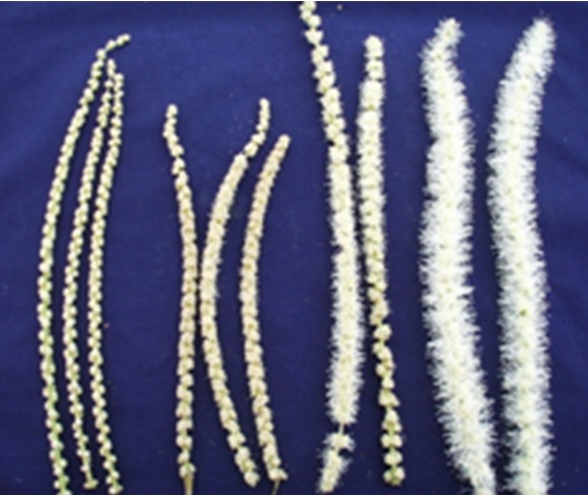
Figure 2 – Chestnut catkins
The female flowers are usually grouped in three inside of a spinach capsule giving rise to the three chestnuts inside the burr (figure 3).
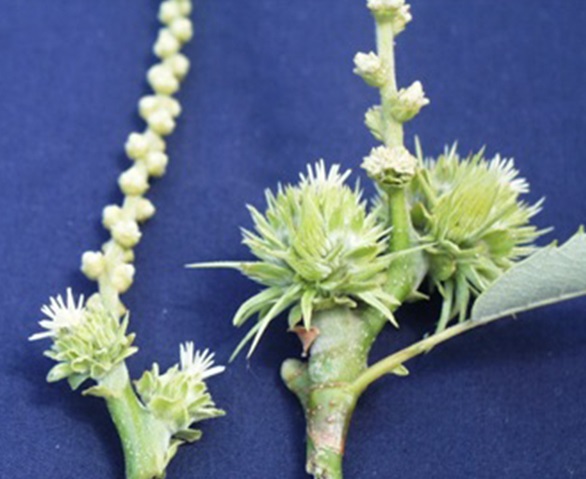
Figure 3 – Female flowers of chestnut
The maturation of the fruits occur in October and November (figure 4).
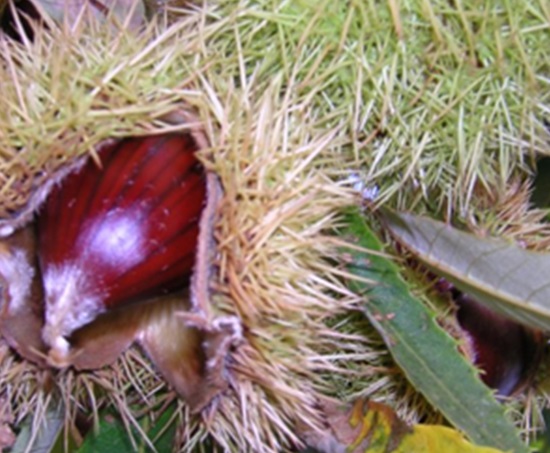
Figure 4 – Chestnut burr
The tree stays in vegetative dormancy between November and March. The chestnut is a monoic species, the same tree has female and male flowers, but it is self-sterile, meaning that cross fertilization is necessary, because the female and male flowers of the same tree are incompatible.
Pollination takes place through wind and insects. It is therefore very important to take into account, when setting up an orchard, that the pollinating varieties must have abundant pollen production, genetically compatible with the female flowers of the variety to be pollinated, and that the full male flowering corresponds to the female flowers receptivity. Male flowering is relatively short: 5 to 8 days in which pollen remains viable, while the period of receptivity of female flowers lasts 5 to 20 days (Bergougnoux et al., 1978). The orchard must have more than two varieties to ensure a good pollen coverage, since the climate variations can influence the evolution of the different floral stages. Good pollination also requires high temperatures and good weather, for pollen transport to be effective. It is mainly bees that ensure pollination, much more than wind.
At 8, 10 years the chestnut tree already produces fruit however, only after the 20 the fruiting becomes regular. Up to age 50-60, growth is fairly rapid, then decreasing to the end of life. A chestnut tree can reach 45 meters in height and its canopy can reach 30-40 meters in diameter (figure 5).
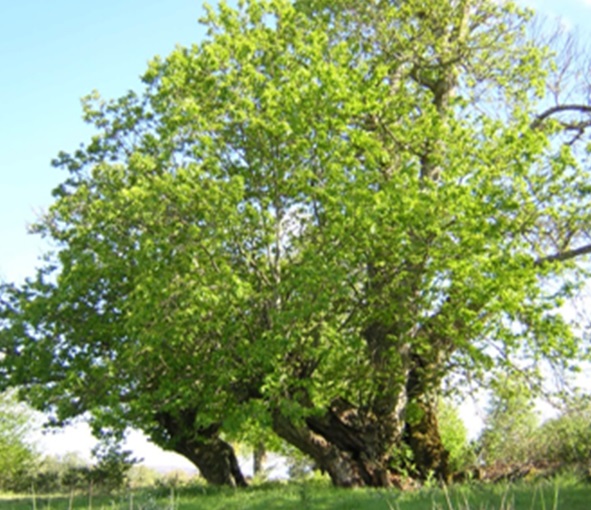
Figure 5 – Centenary Chestnut in Viseu region
Exploitation and vegetative propagation
Chestnut is a woody tree that can reach more than one thousand years. It may be associated with certain oaks. It is exploited for the production of fruit (in orchards) and for the production of wood (in high forest or coppice ) (Figures 6).
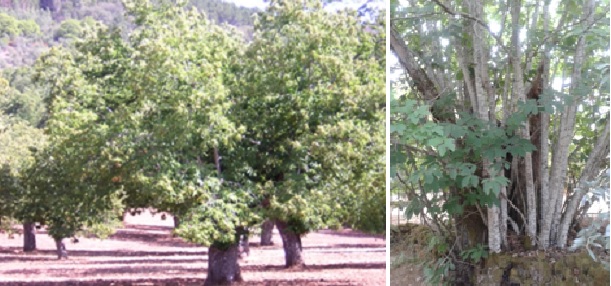
Figure 6 – Centenary orchard in Marvão region (left) and coppice in Serra da Gardunha (right)
In Portugal, Bravo is the denomination of chestnut tree exploited for timber production. It is usually originated from seeds. Manso is the chestnut used for fruit production in orchards, normally grafted at age of 2-4 years.
The first are cultivated as high stems or coppices, for timber production of big and small dimensions respectively. For the high stem the distance between trees is usually 4x2 meters. Thinning is done at the end of 2-5 years, to select the best trees and the final cut occurs around 50-60 years, when the stand has 170-200 trees / hectare. A high stand is converted into coppice after the final cut. Coppice has rotations of 15 years (Costa, 2005).
In orchards, the distance between the trees can vary between 8 and 12 meters to give enough space for the crowns to grow. In the new plantations, installed with irrigation, the distance can been lowered to 6 and 7 meters, for a more intensive exploitation to increase the yield in the first years of production. When the crowns begin to compete, a thinning may be performed. The treatments to be carried out after planting are very similar to any fruit tree. It is necessary to mobilize the soil before planting as well as fertilize it. Grafting is widely used in fruit varieties and rootstocks should be resistant to root rot, caused by the oomycete of the genus Phytophthora that attacks the roots. The main methods used for the propagation of chestnut trees are by seed, grafting and rooting sprouts called amontoa in Portuguese (Figure 7).
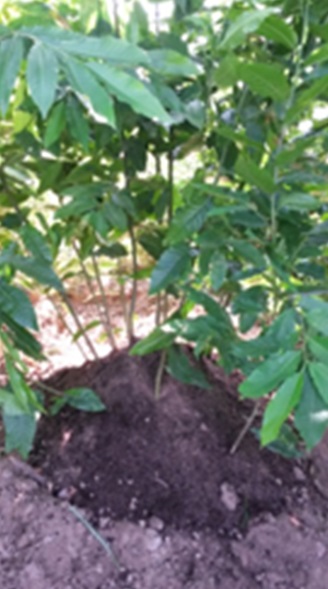 Figure 7 – Vegetative propagation by rooting sprouts (Amontoa)
Figure 7 – Vegetative propagation by rooting sprouts (Amontoa)
The Portuguese varieties of chestnut
In Portugal, Longal is the oldest variety, which is distributed throughout all production regions, being considered the best variety for the industry. The varieties Judia and Martaínha are usually preferred for fresh market, due to their greater size. Some varieties such as Longal, Amarelal and Verdeal are also found in Northern Spain (Costa et al., 2008, Pereira-Lorenzo et al., 2011).
.
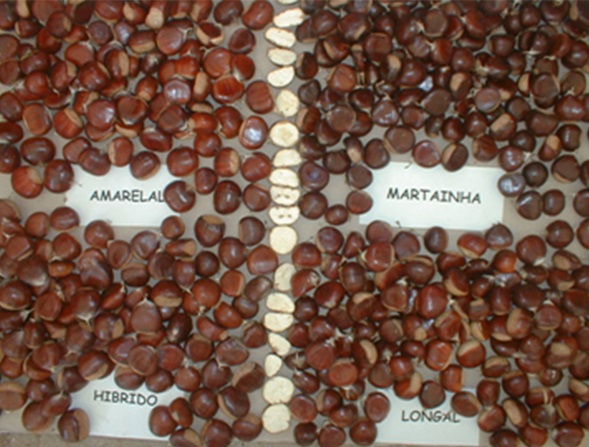
Figure 8 – Portuguese Chestnut varieties
Due to the growing market demands for quality products and the preservation and enrichment of the national genetic heritage, demarcated regions with protected denominations of origin (DOPs) have been created in Portugal;
Castanha da Terra Fria - includes the varieties of Longal, Judia, Cota, Amarelal, Lamela, Aveleira, Boaventura, Trigueira, Martaínha and Negral. More than 70% of the production correspond to the Longal variety, the remaining 30% to other varieties. This DOP is located in Trás-os-Montes, in the municipalities of Alfândega of Fé, Bragança, Chaves, Macedo de Cavaleiros, Mirandela, Valpaços, Vimioso and Vinhais, covering an area of about 12,500 hectares;
Castanha da Padrela - its geographical area is circumscribed to some parishes of the municipalities of Chaves, Murça, Valpaços and Vila Pouca de Aguiar, corresponding to about 4,600 hectares. Includes the varieties Judia, Lada, Negral, Cota and Preta;
Soutos da Lapa - Includes the varieties Martaínha and Longal. The production area comprises some parishes of the municipalities of Aguiar da Beira, Armamar, Lamego, Moimenta da Beira, Penedono, S. João da Pesqueira, Sernancelhe, Tabuaço, Tarouca and Trancoso covering an area of about 4,000 hectares;
Castanha de Marvão - Includes Bária and Colarinha varieties. The geographical area is restricted to the municipalities of Marvão, Castelo de Vide and Portalegre, occupying about 550 hectares.
Nutritional qualities of chestnuts
Chestnut has some advantages when compared with other nuts:
- it is less caloric (it has about one third of the calories of others), has low fat and is significantly rich in vitamin C, which helps to strengthen the immune system;
- is rich in starch, is an energetic food, cholesterol-free and low in fat, helps to combat arteriosclerosis;
- has no gluten, it is recommended in the diet of celiac patients;
- has low concentration of soluble sugars, has anti-diabetic effect;
- has low content of sodium.contributes to reduce blood pressure;
- is rich in vitamin C and calcium, prevents osteoporosis;
- has high content of potassium and phosphorus, helps to regulate the heart beat;
- is rich in folic acid, helping to reduce the stress.




